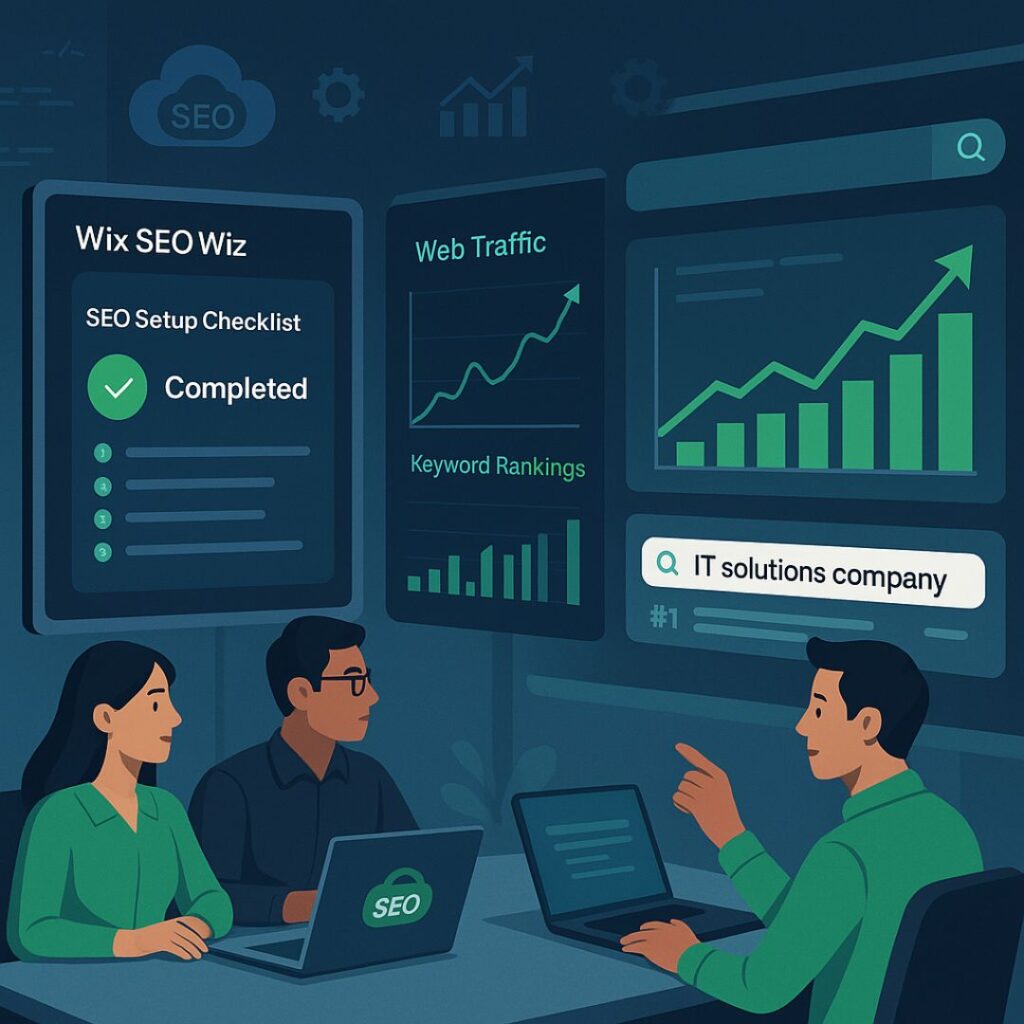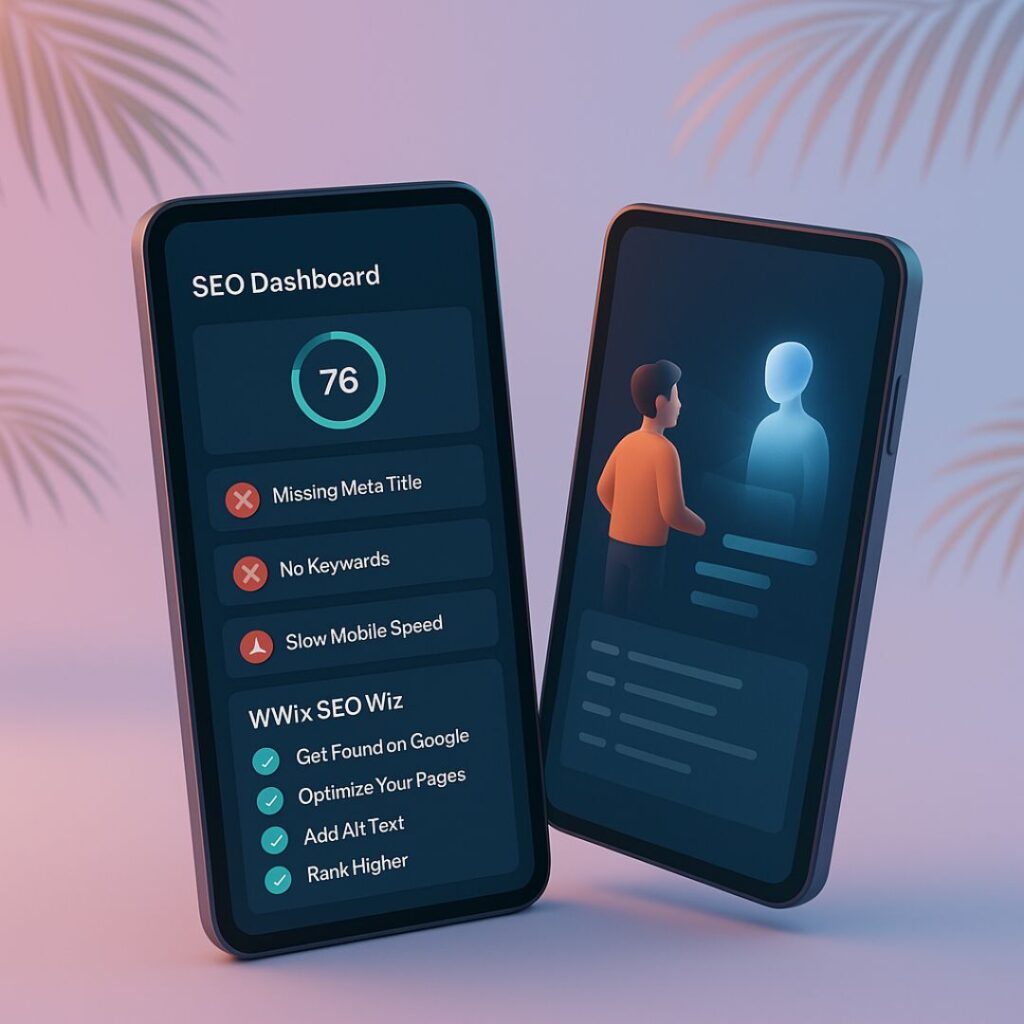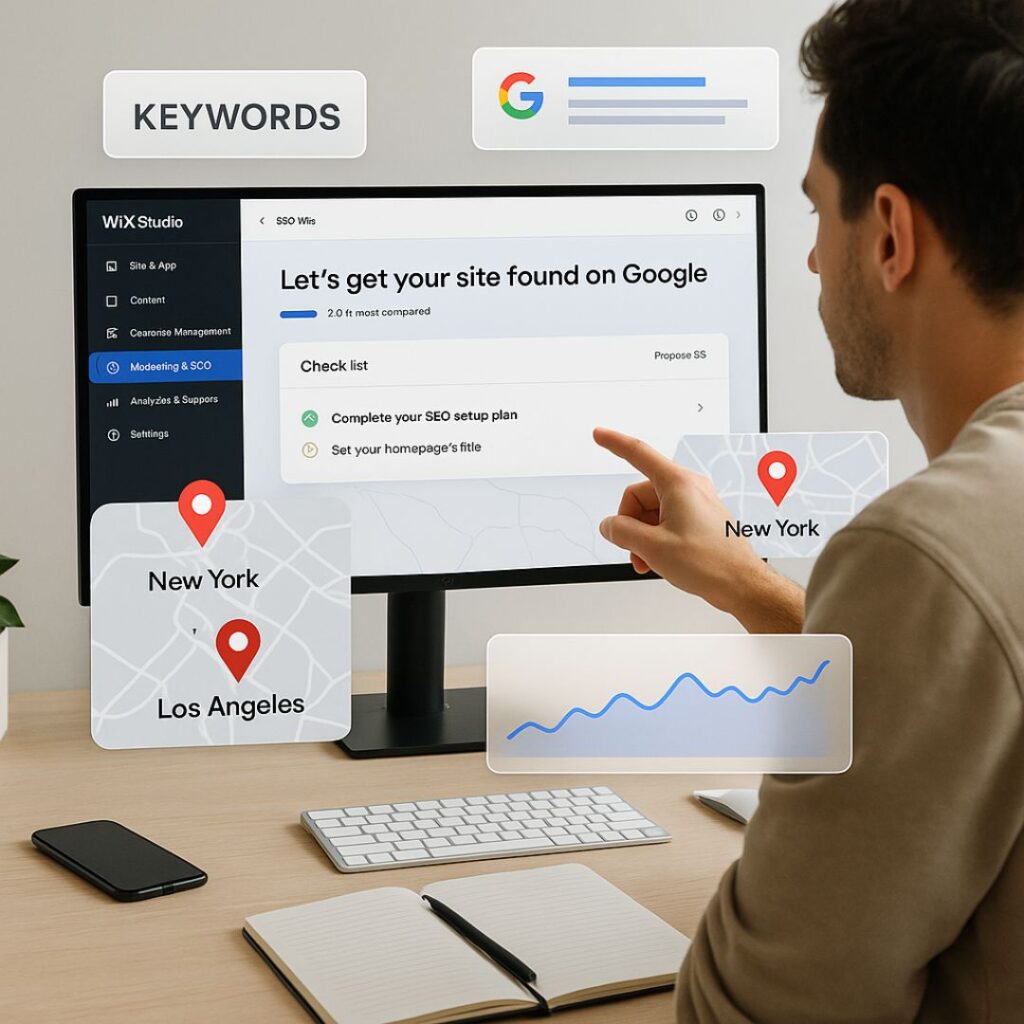How Wix SEO Wiz Helps USA Companies Get Found on Google
Introduction to Wix SEO Wiz
What is Wix SEO Wiz?
Wix SEO Wiz is an intuitive SEO tool designed specifically for Wix users. It helps businesses improve their website’s visibility on Google through a personalized, step-by-step SEO plan—no technical skills required.
Why It Matters for U.S. Businesses
In the crowded U.S. digital market, visibility is everything. Whether you’re a New York bakery or a Texas-based ecommerce store, ranking on Google can make or break your online success. Wix SEO Wiz gives you a roadmap to improve your SEO without hiring an expensive agency.

Key Features of Wix SEO Wiz
Step-by-Step SEO Plan
Once you answer a few questions about your business, Wix SEO Wiz creates a custom plan tailored to your niche and goals.
Personalized Checklist
Get tasks like “Add alt text to images” or “Connect your site to Google” delivered in a checklist format you can check off one by one.
Google Integration Made Easy
You can connect your site to Google Search Console right from the dashboard, helping you index your pages and monitor performance effortlessly.
Real-Time SEO Feedback
As you make changes to your site, the SEO Wiz gives you live feedback—think of it like having an SEO coach in your browser.
 Why Wix SEO Wiz is Perfect for Small Business Owners
Why Wix SEO Wiz is Perfect for Small Business Owners
No Technical Skills Needed
Wix designed the SEO Wiz for entrepreneurs, not coders. Anyone can follow the recommendations and get results without writing a single line of code.
Affordable SEO for Budget-Conscious Brands
Don’t want to pay hundreds per month to agencies? Wix SEO Wiz offers powerful results—free with your Wix plan.
 Wix SEO Wiz vs Traditional SEO Tools
Wix SEO Wiz vs Traditional SEO Tools
Simplicity and Automation
Unlike tools like Ahrefs or SEMrush, Wix SEO Wiz doesn’t overwhelm you with data. It guides you through what actually needs to be done.
Built Specifically for Wix Users
Because it’s built right into the Wix ecosystem, it understands your site’s architecture and offers more relevant advice than general tools.
 Setting Up Wix SEO Wiz
Setting Up Wix SEO Wiz
Getting Started with the SEO Wiz
Log in to Wix.
Navigate to the SEO Tools.
Launch Wix SEO Wiz.
Answer a few questions.
Get your custom SEO plan.
Connecting Your Domain to Google
The tool helps you verify ownership and submit your site to Google Search Console without needing DNS knowledge.
Tracking Your Progress
The dashboard shows your SEO health, including how many tasks are complete and which ones need attention.
 Real Benefits for USA-Based Companies
Real Benefits for USA-Based Companies
Local SEO Optimization
Wix SEO Wiz lets you focus on location-based keywords like “best bakery in Chicago” or “Dallas real estate agent.”
Increased Organic Traffic
With proper setup, many U.S. users report traffic increases within 30-60 days.
Improved Search Rankings
Keyword-optimized content and meta data help you climb Google’s ranks—without the SEO jargon.
 Using Wix SEO Wiz for Ecommerce Success
Using Wix SEO Wiz for Ecommerce Success
Product Page Optimization
Add titles, meta descriptions, and keyword-rich product names easily.
Metadata for Better Conversions
Search-optimized titles and descriptions improve click-through rates from Google.
Mobile Optimization
Every Wix site is mobile-responsive, ensuring a smooth experience across devices.
 LSI Keywords to Use with Wix SEO Wiz
LSI Keywords to Use with Wix SEO Wiz
Sample Keywords to Target
Wix SEO for small business
how to rank Wix site on Google
best Wix SEO settings
Google Search Console Wix
Wix SEO checklist
Tips to Use Keywords Naturally
Include them in headers (H1, H2)
Use variations in blog content
Avoid keyword stuffing—use synonyms
 Long-Tail vs Short-Tail Keywords for U.S. Brands
Long-Tail vs Short-Tail Keywords for U.S. Brands
Why Long-Tail Keywords Matter
Phrases like “affordable web designer in Brooklyn” convert better than broad ones like “web design.”
How Wix Helps You Target the Right Ones
SEO Wiz lets you enter long-tail focus keywords that help Google understand the context of your content better.
 On-Page SEO Features in Wix Studio
On-Page SEO Features in Wix Studio
Meta Titles and Descriptions
Customize each page’s metadata to match your target keywords and attract clicks.
Alt Text for Images
Ensure your images are SEO-friendly and accessible.
URL Structure and Redirects
Wix allows clean URLs and easy redirects, which keeps your site user- and SEO-friendly.
 SEO Wiz & Mobile-First Indexing
SEO Wiz & Mobile-First Indexing
Why Mobile Optimization is Critical
Google prioritizes mobile versions of websites. If yours isn’t mobile-friendly, your rankings suffer.
Wix’s Responsive Design Advantage
Wix sites are built with mobile-first indexing in mind—no extra effort needed.
 SEO Wiz & Google Search Console Integration
SEO Wiz & Google Search Console Integration
Connecting & Verifying Your Site
One-click setup means you can get verified with Google in minutes.
Submitting Your Sitemap
The SEO Wiz automatically creates a sitemap and helps you submit it for indexing.
 Common SEO Mistakes to Avoid
Common SEO Mistakes to Avoid
Ignoring Metadata
Skipping your titles and descriptions? You’re leaving traffic on the table.
Keyword Stuffing
It’s 2025—not 2005. Focus on quality, not stuffing.
Neglecting Page Speed
Slow sites don’t rank. Wix’s performance tools help keep things zippy.
 Tracking Results with Wix SEO Tools
Tracking Results with Wix SEO Tools
Analyzing Traffic with Wix Analytics
Track visitors, bounce rates, and more—right from your dashboard.
Understanding Keyword Rankings
See how your keywords are performing and adjust strategy accordingly.
FAQ's
1. Is Wix SEO Wiz free to use?
Yes, it’s included in all Wix plans.
2. How long does it take to see results?
Most users see improvements within 30 to 60 days after implementation.
3. Can I use Wix SEO Wiz for local SEO?
Yes, it’s designed to help you rank for location-specific keywords in the U.S.
4. Do I need to install any plugins?
No plugins needed—everything is built into the Wix platform.
5. Will it help my ecommerce store rank better?
Definitely! It optimizes product pages, metadata, and site structure for better visibility.
🎯 Conclusion: Is Wix SEO Wiz Right for You?
Absolutely. Whether you’re just getting started or need to improve a poorly ranking site, Wix SEO Wiz gives you all the essential tools in one place. For USA-based small businesses, it’s a game-changer—affordable, easy to use, and designed to get you found on Google fast.
For businesses seeking creative and technical excellence without the bloat of legacy systems, partnering with a Contra-vetted agency like IZMHS might just be the smartest move in 2025.











